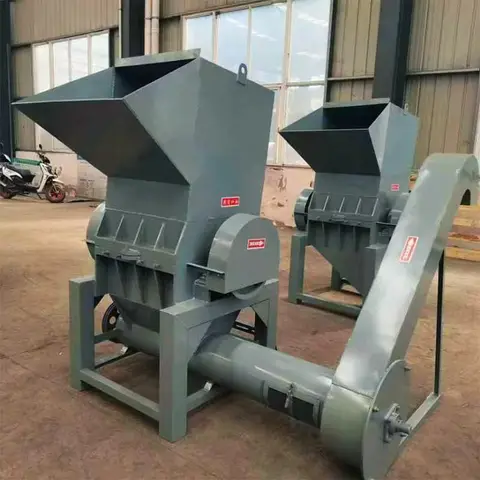
Shredder from alibaba.com

The production of plastic bricks involves a series of sophisticated machinery and meticulous operations aimed at transforming discarded plastic waste into durable building materials. This innovative process not only mitigates the environmental impact of plastic pollution but also offers a cost-effective solution for sustainable infrastructure development. Let's explore the machineries used, rough costing, and operational aspects involved in the manufacturing of plastic bricks.
Machinery Used:
- Shredder:
- The first step in the process involves shredding the collected plastic waste into smaller fragments. Industrial shredders equipped with sharp blades or rotary cutters efficiently break down the plastic materials into uniform pieces.
- Extruder:
- Once shredded, the plastic fragments are fed into an extruder, a machine that applies heat and pressure to melt the plastic. The molten plastic is then forced through a die to form a continuous shape, such as a cylindrical rod or a flat sheet.
- Mixer or Blender:
- In some cases, additional materials such as sand, aggregate, and binding agents are mixed with the melted plastic to enhance the strength and durability of the final product. Mixers or blenders are used to ensure thorough mixing and uniform distribution of the materials.
- Molding Machine:
- The molten plastic mixture is then transferred to a molding machine, where it is shaped into bricks of desired dimensions. Molding machines can vary in size and complexity, ranging from manual or semi-automatic models to fully automated systems.
- Cooling System:
- After molding, the plastic bricks undergo a cooling process to solidify and stabilize their structure. Cooling systems, such as air cooling or water cooling methods, help expedite the cooling process and ensure uniformity in the finished bricks.
Rough Costing:
The cost of setting up a plastic brick manufacturing unit can vary depending on several factors, including the scale of production, the quality of machinery, and the availability of raw materials. Here's an estimated breakdown of the costs involved:
- Machinery and Equipment:
- The initial investment in machinery, including shredders, extruders, mixers, molding machines, and cooling systems, can range from tens of thousands to several hundred thousand dollars, depending on the capacity and specifications of the equipment.
- Raw Materials:
- The cost of raw materials, primarily plastic waste, may vary depending on factors such as sourcing, transportation, and processing. While recycled plastic materials are generally more cost-effective than virgin plastics, fluctuations in market prices can impact overall production costs.
- Labor and Operational Expenses:
- Labor costs associated with machine operation, maintenance, and quality control are significant considerations. Skilled technicians and operators are required to oversee the production process and ensure the efficiency and quality of the output.
- Utilities and Overhead Costs:
- Additional expenses, such as electricity, water, rent or lease of manufacturing space, and administrative overheads, contribute to the overall operational costs of the manufacturing unit.
Operational Aspects:
- Collection and Sorting:
- The process begins with the collection and sorting of plastic waste from various sources, including households, businesses, and recycling centers. Efficient logistics and sorting mechanisms are essential to ensure a steady supply of raw materials.
- Preparation and Processing:
- The collected plastic waste is sorted, cleaned, and shredded into smaller fragments. These fragments are then fed into the extruder, where they are melted down and mixed with other materials if required.
- Quality Control:
- Throughout the production process, stringent quality control measures are implemented to monitor the consistency, strength, and dimensional accuracy of the plastic bricks. Regular testing and inspection help identify and rectify any defects or deviations from specifications.
- Packaging and Distribution:
- Once the plastic bricks are molded and cooled, they are ready for packaging and distribution. Proper packaging ensures protection during transportation and storage, while efficient distribution channels help reach customers and construction projects in a timely manner.
- Maintenance and Upkeep:
- Regular maintenance and upkeep of machinery are essential to ensure optimal performance and longevity. Scheduled inspections, lubrication, and repairs help prevent downtime and maintain productivity levels.
Conclusion:
The production of plastic bricks involves a sophisticated blend of machinery, operations, and cost considerations aimed at transforming plastic waste into valuable building materials. By leveraging innovative technologies and sustainable practices, manufacturers can contribute to environmental conservation while meeting the growing demand for cost-effective and eco-friendly construction solutions.
As the global emphasis on sustainability continues to grow, the adoption of plastic brick manufacturing offers a promising pathway towards a circular economy, where waste is repurposed and resources are utilized more efficiently. With continued investment in research, development, and infrastructure, the production of plastic bricks has the potential to revolutionize the way we build and pave the future for sustainable infrastructure worldwide.